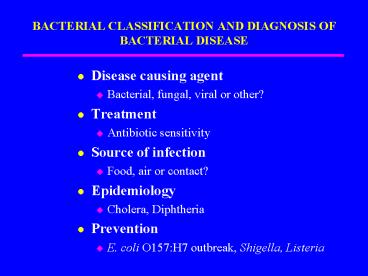BACTERIAL CLASSIFICATION AND DIAGNOSIS OF BACTERIAL DISEASE - PowerPoint PPT Presentation
Title:
BACTERIAL CLASSIFICATION AND DIAGNOSIS OF BACTERIAL DISEASE
Description:
Disease causing agent Bacterial, fungal, viral or other? Treatment Antibiotic sensitivity Source of infection Food, air or contact? Epidemiology Cholera, Diphtheria – PowerPoint PPT presentation
Number of Views:144
Avg rating:3.0/5.0
Title: BACTERIAL CLASSIFICATION AND DIAGNOSIS OF BACTERIAL DISEASE
1
BACTERIAL CLASSIFICATION AND DIAGNOSIS OF
BACTERIAL DISEASE
- Disease causing agent
- Bacterial, fungal, viral or other?
- Treatment
- Antibiotic sensitivity
- Source of infection
- Food, air or contact?
- Epidemiology
- Cholera, Diphtheria
- Prevention
- E. coli O157H7 outbreak, Shigella, Listeria
2
Antibiotic sensitivity
3
Site of sampling
- Sterile sites
- Blood
- Cerebrospinal fluid (CSF)
- Body fluids (Peritoneal and pleural)
- Non-sterile (normal flora)
- Respiratory tract
- Ear, eye and mouth
- Skin (wound and abscess)
- Urine (mid-stream)
- Feces
4
Bacterial classification
- Wall structure
- Gram
- Staphylococcus, Streptococcus, Clostridium,
Bacillus - Gram -
- Enteric, respiratory and others
- Acid-fast
- Mycobacterium
- Wall-less
- Mycoplasma
- Unusual
- Obligate intracellular
- Rickettsia, Chlamydia
Bacteria
G G- AF WL IC
5
Bacterial classification
- Cell morphology
- Shapes
- Rod
- Cocci
- Spiral
- Associations
- Individual
- Diplo-
- Staphylo-
- Strepto-
Bacteria
G G- AF WL IC
Rod Cocci
Rod Cocci Spiral
6
Bacterial classification
- Growth characteristics
- Oxygen requirement
- Aerobic
- Anaerobic
- Microaerophilic, aerotolerant
- Facultative
- Spore formation
- Intracellular/extracellular
- Fastidious/non-fastidious
Bacteria
G G- AF WL IC
Rod Cocci
Rod Cocci Spiral
/- -O2
spore -
7
Classification Diagnosis
- Type of colonies
- Appearance
- Color, shape, size and smoothness
- On differential media
- Blood, MacConkey, EMB
- On selective media
- MacConkey, Thayer-Martin
8
Classification Diagnosis
- Metabolism
- Utilization of specific substrates
- Lactose (Sal/Shi/Yer/)-
- Citrate (E. coli-/Klebsiella)
- Production of certain end products
- Fermentation end products
- Acid (acetate, propionic acid, butyric acid etc.)
- Acetoin
- Alcohol
- Amine
- H2S
9
Classification Diagnosis
- Specialized tests
- Immunological
- O-, H- K-Ag (serotype)
- Precipitation, agglutination
- Specialized enzymes
- Catalase--- Staph. vs. Strep-.
- Coagulase---S. aureus vs. S. epidermidis-
- Oxidase---Neisseria gonorrhoea
- Urease---Proteus, Helicobacter
- Antibiogram pattern
- Phage typing
- Fatty acid profile
10
Immunological detection
11
Conventional diagnosis methods
12
Conventional method
- Depend on ability to culture
- Treponema pallidum
- Slow, esp. for fastidious species
- Mycobacterium spp.
- Not always definitive
13
Molecular diagnosis
- Ribotyping
- Restriction fragment length polymorphism (RFLP)
- DNA hybridization
- PCR, RT-PCR and RAPD
- Nucleic acid sequence analysis
- Phage-GFP (TB)
14
RFLP
GGATCC CCTAGG
15
DNA hybridization
16
In situHybridization
17
PCR
RT-PCR
Rate of increase 2n
18
RAPD of P. aeruginosa
19
Molecular diagnosis
- Reduce reliance on culture
- Faster
- More sensitive
- More definitive
- More discriminating
- Techniques adaptable to all pathogens
- Technically demanding
- Relatively expensive
- Can be too sensitive
- Provides no information if results are negative
20
Differentiating Staphylococci from Streptococci
- Gram stain and morphology
- Both Gram
- Staphylococci bunched cocci
- Streptococci chained cocci (S. pneumoniae form
diplococcus) - Enzyme tests
- Staphylococci catalase
- Streptococci catalase -
- Growth
- Staph. large colonies (non-fastidious), some
hemolytic - Strep. small colonies (fastidious), many
hemolytic (a or b)
21
Staphylococci
- S. aureus coagulase
- S. epidermidis coagulase -
22
Streptococci
23
Differentiating the Gram- bacteria
- Cocci
- Neisseria
- Rods
- Type of disease they cause
- Enteric Gram- rods
- API test
- Curved
- Vibrio, Campylobacter, Helicobacter
- Spiral Gram- organisms
- Spirochetes
24
Gram negative
Curved rods
Straight rods
Lactose Lactose-
TCBS agar Yellow Oxidase Vibrio
Campy blood agar 42oC 25oC- Campylobacter
Citrate Citrate-
H2S H2S-
Klebsiella E. coli Salmonella
Shigella
25
Bacteria
Intra Cellular
Wall Less
Gram
Gram-
Acid Fast
Cocci
Rod
Cocci
Rod
Spiral
M.t. M.l. N.c.
Rickettsia Coxiella Erlichia Chlamydia
Mycoplasma
Staph.
Strep.
Non-spore
Spore
Treponema Borrelia Leptospira
Neisseria Moraxella
Fil
Rod
O2
-O2
Curve
B.a. B.c.
C.b. C.t. C.p. C.d.
S. a. S. e. S. s.
A B Pn Vir
A.i.
C.d. L. m.
Straight
Vibrio Campylobacter Helicobacter
O2
-O2
/-O2
Other
P.a.
Enteric
Bact.
Resp.
Zoo
GU
H. ducreyi Gardnerella Calymmatobacterium
Yersinia Pasteurella Brucella Francisella Streptob
acillus
Bordetella. H. influenzae Legionella































